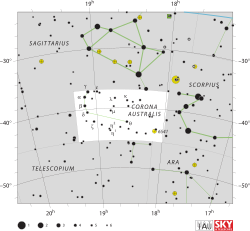Alpha Coronae Australis
| Observation data Epoch J2000.0 Equinox J2000.0 (ICRS) |
|
|---|---|
| Constellation | Corona Australis |
| Right ascension | 19h 09m 28.34097s |
| Declination | –37° 54′ 16.1022″ |
| Apparent magnitude (V) | 4.102 |
| Characteristics | |
| Spectral type | A2Va |
| U−B color index | +0.06 |
| B−V color index | +0.04 |
| Astrometry | |
| Radial velocity (Rv) | −18.4 km/s |
| Proper motion (μ) |
RA: 84.87 mas/yr Dec.: −95.99 mas/yr |
| Parallax (π) | 26.02 ± 0.25mas |
| Distance | 125 ± 1 ly (38.4 ± 0.4 pc) |
| Absolute magnitude (MV) | 1.11 |
| Details | |
| Mass | 2.3 M☉ |
| Radius | 2.3 R☉ |
| Luminosity | 31 L☉ |
| Temperature | 9,100 K |
| Rotational velocity (v sin i) | 195 km/s |
| Age | 254 Myr |
| Other designations | |
| Database references | |
| SIMBAD | data |
Alpha Coronae Australis (α CrA, α Coronae Australis) is a star in the constellation Corona Australis. It is the only star in the constellation with a proper name, Alphekka Meridiana (Alphekka South), after the brightest star in Corona Borealis, Alphecca. In Chinese astronomy, it is known as 鱉六 (the Sixth Star of the River Turtle). It is a Class A star like Vega, rotating extremely fast on its axis, close to its breakup velocity.
Alpha Coronae Australis belongs to the spectral class A2Va and has apparent magnitude +4.10. Located about 125 light years from Earth, the star's mass and radius are estimated at 2.3 times solar. With an effective temperature of roughly 9,100 K, the star radiates a total luminosity of about 31 times solar. This star is roughly 254 million years old. A rapidly rotating star, it spins at almost 200 km per second at the equator, making a complete revolution in approximately 14 hours. Like the star Vega, it has excess infrared radiation, which indicates it may be ringed by a disk of dust.
The name Alphecca or Alphekka is Arabic, short for نير الفكّة nayyir al-fakka "the bright (star) of the broken (ring of stars)".
In Chinese, 鱉 (Biē), meaning River Turtle, refers to an asterism consisting of α Coronae Australis, α Telescopii, η1Coronae Australis, ζ Coronae Australis, δ Coronae Australis, β Coronae Australis, γ Coronae Australis, ε Coronae Australis, HD 175362, κ2 Coronae Australis and θ Coronae Australis. Consequently, α Coronae Australis itself is known as 鱉六 (Biēliù, English: the Sixth Star of River Turtle.).
...
Wikipedia

